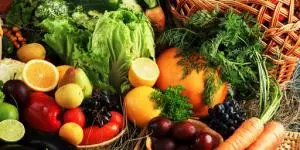We all know that a healthy and balanced diet should be rich in fruits and vegetables. However, when it comes to saying what exactly a fruit or a vegetable is, not everyone is so clear on it and both terms seem to be included, popularly and sometimes, in that large group of healthy plant foods of which little else matters. However, the truth is that there are differences and they are important.
If you’ve ever wondered: is avocado a fruit or a vegetable? or is the tomato a fruit or a vegetable? and you want to learn more about the difference between fruit and vegetables, join us in this curious article.
Difference between fruit and vegetable – summary
First of all, the first thing that must be said is that the terms fruit and vegetables are not technical nor are they used in botany with the usual meaning that is given to them when talking about them as food in our day-to-day life. Once this is clarified, we can move on to the distinction between the two concepts. This is the difference between fruit and vegetables.
- A fruit is the part of the fruit that we eat , that is, the fertilized ovary that the plant creates around the seed or seeds. It’s that simple, the fruit is always part of the fruit and, therefore, always has a reproductive function in the plant.
- A vegetable is any other part of the plant that is not the fruit and that people consume as food . It can be the leaves, the root, the stems or even the flowers, in all these cases it is considered a vegetable. In fact, if the consumption of leaves, stems, flowers or roots of any plant became popular, the term vegetable would be immediately applicable. As you can see, it is a very vague and non-specific term, useful for day-to-day life but which can give rise to many confusions or errors if we want to specify or talk about something technical in the scientific field.
What is a fruit and examples
As we have already mentioned, a fruit is a part that we eat of the fruit of a plant and that, therefore, contains seeds in the vast majority of occasions, unless it is a question of varieties modified for human consumption, as is the case of the triploid or seedless watermelons that we can find in supermarkets today. Let’s look at some examples of fruits that tend to be confused with vegetables:
- Tomatoes
- Eggplant
- Avocado
- Pepper
- Cucumber
- Pumpkin
- chili
Is the tomato a fruit or a vegetable?
The tomato is obviously a fruit, as it contains the seeds of the plant. Where then does the usual confusion of considering it a vegetable come from?
We have to go back to the year 1887, in the United States. The Supreme Court had just approved a law according to which imported vegetables must pay taxes from which fruits are exempt. Tomato importers, trying to avoid the tax, argued, citing biologists and dictionaries, that the tomato was a fruit, as it fits the botanical term that designates them. The government, on the other hand, did not see it so clearly: if the tomato was served as a dessert or in salads, that made it a vegetable. This decision, which had very little to do with botany, has provoked numerous discussions to this day.
Are strawberries fruits?
Another case that deserves specific mention is strawberries. Strawberries are not fruits as such, but fruits. This is a union of fruits that grow so close together that they look like a single fruit. The small yellow dots on strawberries are therefore not seeds, but actually small fruits, and within them are the seeds themselves.
What is a vegetable and examples
Vegetables, as we have also mentioned, are basically any edible part of a plant other than the fruit. Their shapes and aspects are even more varied than those of fruits since they are a vegetable both the leaf of spinach and the great flower of a cauliflower. They can be divided according to the part we consume and these are some examples of vegetables :
- Leaves: lettuce and spinach.
- Bulbs: garlic and onion .
- Flowers: cauliflower and artichoke.
- Roots: radish and carrot .
- Tubers: potato and sweet potato.
- Stems: asparagus and celery.
- Seeds: lentils , rice and beans .
Vegetables have a huge impact on human food and the economy around the world. Without going any further, only wheat and corn account for 40% of the food source for humans worldwide, and 25% of the total calories consumed. Rice is also basic, without which the diet of Asian countries would not even be similar. We cannot forget tubers such as potatoes, sweet potatoes, and cassava, which are also vital in a large number of cuisines. The latter, in fact, is an essential part of the diets of much of South America and Africa, and a very important contribution of nutrients for communities that do not have regular access to meat due to the scarcity of livestock. Other vegetables such as carrots, lettuce, onion, asparagus, chickpeas or lentils,
